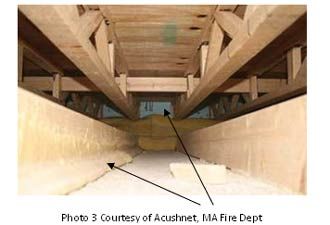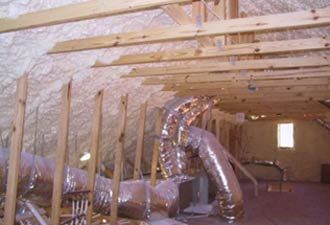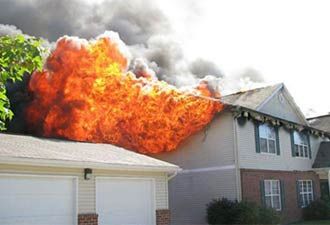A disposable structure is defined as: (Bowker’s definition) “Lightweight wood frame construction that utilizes engineered wood assemblies of lesser mass and/or synthetic products, that contribute significantly as fuel, and have a faster flame spread and failure time when exposed to fire and/or heat than does traditional solid dimension wood frame construction.” This includes site-built and factory-built structures.
In addition, fire loads have dramatically changed since the 1950s from that of natural fiber materials to to primarily synthetic based. This has contributed significantly to faster developing fires, with less time to flashover, less time for escape, and less time to structural failure.
Another significant risk facing firefighters involves manufactured and modular constructed homes and buildings. The 2009 International Residential Code now allows manufacturers to use polyurethane foam construction adhesive in lieu of mechanical fasteners (screws or nails) to install gypsum wallboard to interior ceilings and walls of these structures.
This highly combustible adhesive off-gases at approximately 480 F. With early failure of the compartment, very rapid fire spread throughout the structure should be expected.
 View of Polyurethane foam adhesive attaching gypsum ceiling board to the wooden structural frame in the void space between floors. The floor voids are typically 14' x 48' x 20" per modular unit, which equals approximately 1300 cubic ft, and may have multiple attached units. It is doubtful that the code developers thought beyond the 1000 sq ft. requirement using the standard. |
 View of attic void in modular structure with spray-on foam insulation covering underneath side of roof. Note the 2 x 4 inch knee-wall construction supporting the roof structure. |
Void space dangers
Firefighters face a very serious threat once the fire in a disposable structure enters the truss void space underneath the floor(s) or in the attic. Large open void spaces are common to all lightweight wood frame structures. These void spaces provide an abundance of exposed fuel surfaces and plenty of air for a fire to rapidly develop and violently spread throughout the void. Attic and floor voids create very effective “fire boxes” within the structure.
Exposed fuels may consist of compressed wood products, polyurethane binding and construction adhesives, PVC plumbing, plastic wrapped duct work, and electrical wiring insulation. Fires that start or extend into the void space, especially from the exterior, have a tendency to become violent very quickly with little or no warning, trapping unsuspecting firefighters conducting interior operations.
It is well documented that once flames or high heat impinges upon exposed wooden lightweight structural components, failure can be expected in as little as 4 to 6 minutes. In addition, void spaces filled with heated fuel vapors create an increased risk of a backdraft, when oxygen is introduced from either unsuspecting firefighters pulling ceilings, or from ceiling panel failure.
Here are some of the dangers a void space fire may present:
- Hidden fire
- Rapid fire spread throughout structure
- Preheating of structural supporting members ahead of the fire
- Accumulation of fire gases and depletion of oxygen
- Increased backdraft potential
- Early structural failure
- Increased fire load from storage and foam insulation
- HVAC unit installation
The risk posed by today’s wood frame structure demands a different tactical approach be taken by firefighters. A change in tactical thinking is needed. The American fire service culture has been hard-wired for many decades, to extend a fast and aggressive interior fire attack, from the unburned side whenever possible.
While this strategy has served us well in certain situations and types of construction, it can be an absolutely lethal approach with disposable wood frame structure fires we are seeing today.
 Fire entering the void space can become a structure fire on steroids. Especially if it becomes wind-driven. Note the vinyl soffits are melted-out allowing the wind to “super-charge” the attic fire. In addition, note the exposure problem being created. |
Fire entering the void space can become a structure fire on steroids. Especially if it becomes wind-driven. Note the vinyl soffits are melted-out allowing the wind to “super-charge” the attic fire. In addition, note the exposure problem being created.
A seemingly non-life threatening fire originating on the exterior of a disposable structure can quickly spread up the synthetic vinyl siding, breach the soffit, and involve the attic space to become a very violent and lethal fire in a matter of moments, trapping occupants and firefighters. This is especially true if the fire becomes wind-driven.
A recommended tactical approach:
- Conduct a 360 walk around before committing personnel
- Follow the 3 Rs: Read the Smoke, Read the Structure and Read the Risk
- Check for extension into the attic or void space
- Determine the wind direction and its impact
- Immediately attack an exterior fire with a high flow appliance if the structure is savable
Do not underestimate the danger of an exterior fire spreading into the attic void via the soffits. This appears to have been the avenue of fire spread at the Galleria Apartments in Fargo, N.D., that resulted in the mayday situation for several firefighters toward the end of last year.
Fires that originate on the exterior, or vent and extend from an opening of a disposable structure, must be controlled quickly, especially if the exterior is covered with vinyl siding. The Blitz attack may be your best option for a quick knock-down, and then followed up with a Cautious Interior Assessment (CIA) if the quick knock-down is successful.
These high BTU producing fires will quickly breach the soffit into the attic void. If the fire is wind-driven, this is a fire on steroids and may blow fire back through the structure from the windward (pressurized) side, to the firefighters entry (vent) point, over-running and cutting off their escape route.
A wind speed as little as 10 mph can create a wind-driven structure fire. Exposures are also at an increased risk with the use of vinyl siding. Research over the dangers of wind-driven residential structure fires conducted by Retired San Antonio Fire Captain William Mora estimates approximately 24 firefighters have died in structure fires over the past eight years where wind was a factor, some involving lightweight wood frame construction.
Fires that gain possession of the void space doom the structure as unsavable in most cases. However, during a working structure fire in a lightweight wood frame apartment building that my department in Winfield, Kansas, responded to over Labor Day weekend in 2000, an elevated master stream was applied early on to an attic fire that was rapidly spreading through the structure’s attic void.
Initial fire attack with 1-3/4" hand lines from the interior had little to no effect on the fire. Quick use of the master stream from an Aerial Platform stopped the fire dead in its tracks. This action saved the structure and limited the fire loss to the attic space above the apartment of origin.
This is contrary to what we’ve been taught for many years, and breaking old cultural habits are difficult, especially if we fail to understand the nature of the fire problem.
Avenues of fire spread into void spaces
Situations that seem minor should be viewed very pessimistically until thoroughly checked out and overhauled. Thermal Imaging Cameras (TICs) are essential for checking hidden locations. It is noteworthy to point out, however, live fire testing video recorded by the National Institute of Standards and Testing (NIST) indicate that TICs may not be able to effectively “see” through wooden floor decks covered with carpet and padding.
The test shows a raging basement fire burning directly underneath the wooden floor deck constructed with wooden TJIs. Catastrophic failure of the floor occurs in less than 6 minutes after fire exposure begins, plunging two “firefighter” manikins into the inferno. The NIST video dramatically illustrates what can happen to unknowing firefighters, that “rush through the door and then fall through the floor.”
In addition to fire extension into the void space from an exterior fire, it can also extend via the following avenues:
- Combustible dryer vents and air ducts
- Anchor points in modular structures
- Failure of polyurethane glued gypsum drywall & ceiling panels in modular structures
- Basements or rooms with missing or no drywall ceilings
- Construction gaps and around electrical fixtures
- PVC plumbing fixtures
- Fires that originate within the void space












